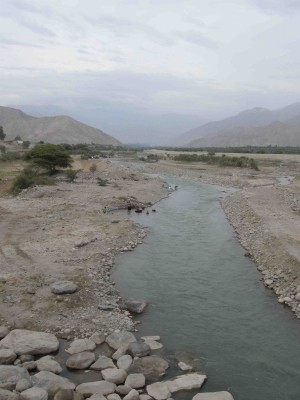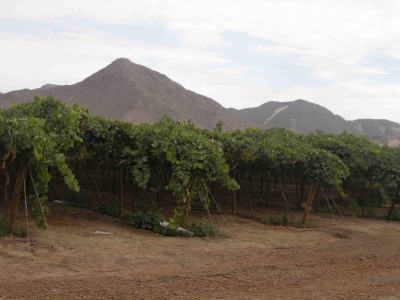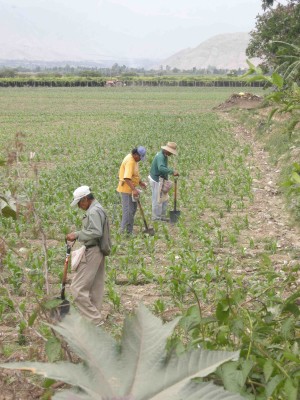
The Ica River meets the sea at one of the driest places on earth; cold upwelling from the Pacific combined with its position near the 30-degree line combine to make this Atacama region almost devoid of rainfall. The river rarely meets the sea anymore, as most of the water is diverted into a series of canals that have long irrigated the agricultural oasis of Ica.
As part of my postdoctoral research for the International Water Security Network, I came to the basin to assess the interrelations of water, food, and energy security through a series of interviews with local producers. The Ica River joins two departments within Peru, and its hotly conflicted water resources offer an opportunity for the University of Arizona’s research in ‘Transboundary water security in the arid Americas.’ Thanks to the support of the Lloyd’s Register Foundation, I am working in collaboration with a team from the Universidad Nacional Mayor de San Marcos in Lima to develop a basin characterization of the water-food-energy nexus along the course of the Ica River.
Ironically, for a valley of little rain, Ica has achieved unprecedented fame during the last two decades for its production of asparagus – Peru dominates trade of asparagus to the United States, Europe, and increasingly, Asia and 95% of this production comes from the Ica Valley. Thousands of hectares of export-oriented agriculture fill the valley and have reclaimed desert at the periphery. Asparagus, artichokes, avocados, mangos, red globe grapes, among other crops have generated an economic boom for the country and provide employment to 40% of the region’s people. Huge trucks stir up incessant dust along the regions dirt roads as the harvests leave the valley, and seed, fertilizers, agricultural supplies and people – as day laborers – arrive to the fields. The crops are also known for using millions of cubic meters of water per year.
The Ica Valley lies 300km south of Peru’s capital city of Lima and extends for over 7,000km2. The river’s headwaters begin on the west slope of the Cordillera de los Andes, at an altitude of 2,500m and flow to the Pacific Ocean. The primary tributaries of the basin emerge from small highland lakes and join to form the Ica River, midway down the extreme elevational gradient. Rains fall in the highlands during the summer months of December to March, and surface flow fills the river. At the end of the rainy season, the river flow diminishes slowly, and dries completely in April. The rains, including in the highlands, are few, and the Ica River is one of the driest of the Peruvian coast. The high variability and short season of surface water led to the creation of water management systems and organizations – since Pre-Hispanic times. The longest of the acequias, or canals, is called La Achirana, and extends 53 kilometers, irrigates 14,000 hectares and involves 8,000 users. This canal diverges from the main channel upstream of the city and meanders through large and small farm fields, lined with dust-coated tropical fruit trees, invasive cane, and native flora, along with wind-blown trash and tethered livestock. A network of smaller acequias threads through the valley, wet or dry, depending on the course of the irrigation water.

Politically, the basin lies within the departments of Ica and Huancavelica; the former, one of Peru’s richest, and the latter, one of the poorest. Water and agriculture within this transboundary basin both reflect and accentuate the political division and conflicts of the two departments. In Ica, national and foreign investment has introduced some of the most modern technology for digitally monitored irrigation, and mechanized planting, harvesting and processing, while in the highlands, families manage small ‘chackras’ of a few hectares and herd mixed flocks of sheep, alpacas and llamas. Concentration of land and water rights has created a distinct divide between the export-oriented producers and the small holders, accentuating power relationships and providing a hotbed for water claims.
In the 1950s, the Peruvian government initiated a series of interbasin transfer projects to bring water from the highland lakes on the eastern side of the Andes, where most of the rain falls and few of the country’s people live, to the western side. The transfer canal, opened in 1959, flows from the Choclococha Lake on the eastern side, through the mountains to a lake at the headwaters of the Ica River, where it is then diverted into the canals that farmers use to irrigate crops along the basin. The interbasin transfer supplies water to the Ica River during the months of September to December, prolonging the season during which farmers can irrigate.
The subterranean waters of the Ica-Villacurí aquifer are some of the country’s most extensive groundwater resources, and extraction began on a small scale in the 1930s. However, in the 1970s, drilling new wells was prohibited to preserve the aquifer levels. In the 1990s, with a legal restructuring to invite private investment and facilitate an export economy, combined with the neoliberal swing of the recently redistributed lands of the Agrarian Reform, the water of the river, even diverting water from the Amazon basin and from existing wells was not enough. Drilling was resumed at unprecedented levels, leading quickly to an overexploitation of the aquifer and the current state of emergency in the Ica Basin.

Any agriculturalist in the valley prefers well water, not only for its superior quality, but also for the private nature of the resource, largely free of state control, and temporally unlimited availability. The region’s climate facilitates year-round agriculture – hence water, rather than land or temperatures is the limiting resource on production. Subterranean water resources are now the primary water resource in the region and directly tied to agricultural export production. In 2010, they accounted for 65% of the region’s water resources (25% still come from the Ica’s natural flow, and 10% from the Choclococha interbasin transfer).
A rapidly declining aquifer, drying wells, and salt water intrusion have forced groundwater users to organize into commissions, like those of surface water users, to have more political power and search for viable alternatives. Well drilling is now prohibited in the region, though largely unenforced – some say that only the largest producers can still drill wells because of their buying power. Producers have employed several alternative mechanisms to continue production, including deepening wells, buying wells distant from their farms and installing pipelines, drilling illegal wells, and buying surface water rights. Lately, they have begun pressuring departmental and national governments to again focus sights on transferring more water from the Amazon basin. The newly promoted Tambo Ccaracocha project, designed to carry water from the high regions of Huancavelica to the Ica Valley to recharge the aquifer has ignited new conflicts within the poorer communities of Huancavelica. These conflicts were taken to the Latin American Water Tribune in Mexico and have yet to find resolution.
I will be in the Ica Valley until early December, from the headwaters to the coast, to understand the complexity of water security – and its contemporaries of food and energy security – along the gradient of the basin. The research may not resolve current tensions, but will perhaps bring insight to the complexity of the issues and provide a larger vision from which to address the science-policy divide and work toward long-term solutions.
